INTERVIEW WITH LINDA KAFKA & MIKE PETERSON
Is the home furnishings industry on the verge of a new way of thinking about
marketing and selling? The co-founders of Science in Design believe it is.
Furniture World recently spoke with Mike Peterson and Linda Kafka,
co-founders of Science in Design, a company that advocates for a new design
paradigm based on neuroaesthetics, biophilia and cognitive architecture.
Many of us have heard the term biophilia, but most don’t know that at its
core, biophilia is not a style, a trend or the incorporation into a space of
a specific set of natural or sustainable materials.
Kafka noted that “the biggest problem many industry people have
understanding the concept, especially designers, is they think that
biophilia is putting a green plant or bamboo in a room. It’s not that at
all. It’s not dependent on notions of sustainability or material. The
industry has been skating around the concept of biophilia that is concerned
with neuroscience and neuroaesthetics.”
Kafka has been active in the design industry since 2009, when as marketing
and managing director of SOFA—Canada’s first design center—she focused on
events, education and community building. In 2009, she first discovered
neuroaesthetics at the exhibit “A Space for Being,” presented during the
2019 edition of Salone del Mobile. “It was a collaborative effort between
Johns Hopkins, Google, Suchi Reddy Architects and the furniture manufacturer
Muuto,” she recalled. “The exhibit’s revolutionary design message was that
feeling follows function as opposed to form follows function. In other
words, it focused on ways interior and exterior environments impact
emotions.
“I started researching the topic then, at the October High Point Market,
attended an event at Century’s Showroom called “Design Harmony” with Mike
Peterson and a panel of designers. That ultimately led to the founding of
Science in Design.”
Before founding Science in Design, Mike Peterson was an advertising
executive at House Beautiful, Country Living and Colonial Homes Magazine. He
spent 10 years in the furniture industry as CEO of LaBarge and at the
furniture manufacturer Madison Square, which he founded. After that, he
became the publisher of Luxe Magazine.
“In 2015, I had a business luncheon with an architect named Don Ruggles,” he
recalled. “Truthfully, I just wanted to sell him a page of advertising. All
he wanted to talk about was how beauty improves health. For the first 15
minutes, the concept went over my head. Then, a small light went on. The
more he talked, the brighter that light became. I thought, if designers
create beauty, and beauty improves health, then designers can improve
health. It’s the old transitivity axiom: If a = b and b = c, a = c.” In
other words, things equal to the same thing are equal to each other.
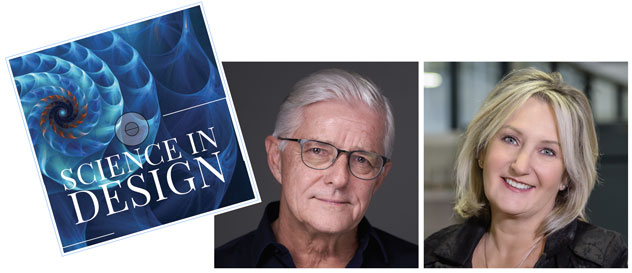
Mike Peterson and Linda Kafka, co-founders of Science in Design
The Pretty Room Problem
“The perception of our industry,” Peterson continued, “is that we exist to
help people create pretty rooms. Our view is that the more important value
proposition, as measured by science, is that we provide an alternative
health resource that’s game-changing and cutting-edge.
“The problem is that most of us who work in design and home furnishings
don’t yet see ourselves that way.” Peterson observed that the furniture
industry tends to be operations focused. “That reality is reflected in the
products our industry produces and how we market products to customers. “I
hope that furniture manufacturers and retailers who read this interview will
realize that the products they sell and the rooms they help create initiate
a sequence of events in our brains that can positively affect people’s
health. It’s a concept that most furniture manufacturers and retailers are
fundamentally unaware of.”
“Regarding Mike’s point,” Kafka added, “hospitals including Johns Hopkins,
the Mayo Clinic and others have validated through research what the interior
design and architectural professions can do to improve health outcomes. Mike
and I bring a lot of passion to our goal of bringing this realization to
interior designers, manufacturers and retailers.”
Relevant Features
“Every time Mike and I walk a trade show, he turns to me and says, ‘There’s
another sign that reads, We sell solid wood furniture. Solid wood is a great
feature. It’s associated in consumers’ minds with durability, but it doesn’t
address the aesthetics of how that furniture makes people feel. How will
that feature impact someone’s life as a human being? In general, furniture
manufacturers are not talking about this. We must ask ourselves how relevant
the features we tell our customers about are to current customers and will
be to people who purchase in the future.”
According to Kafka, the science and its application of biophilia and
neuroaesthetics can provide fresh insight into how the design and home
furnishings sectors might venture into a new marketing paradigm. “We need
some ‘aha’ moments that can lead towards a different vocabulary. The result
will be more traffic in showrooms at High Point and better retail sales. To
me, failing to do that is the definition of insanity. We live in a
competitive digital design world that craves new opportunities and more
experiential stories.” Kafka believes that it’s important to engage people
in a way that makes them say, ‘I absolutely love this space.’ She says
that’s not happening often enough.
Another way of looking at it is to consider how a consumer thinks about a
sofa they just purchased for their home. “They probably aren’t considering
the value of solid hardwood frames and boucle cover that’s 17 percent wool,”
Peterson suggested. “Instead, they are likely admiring its beauty. That
perception is much more than an emotion. It’s a neurological activity that
becomes physical. It causes the brain to light up and release a burst of
serotonin. Beauty isn’t inherent in the physical form of any product. It
resides in the brain. Ten years from now, I believe we will look back and
recognize that the industry has flipped from a manufacturing-driven product
focus to a design model where the human experience is the product we’ve
manufactured.
“Linda and I look at this issue from a scientific perspective and also as
marketers. We realize that the vast majority of furniture retailers and
manufacturers think they are in the business of selling home furnishings.
That’s just not true! They manufacture or buy furniture to sell, but they
should be selling the emotional and physical benefits of those products.”
“We manufacture or buy furniture to sell, but should be selling the
emotional and physical benefits of those products.”
Where Might Retailers Begin?
Kafka said a good place for retailers to start is with the designs of their
showroom spaces.
“When they walk into a store,” Kafka said, “customers should feel relaxed or
excited and want to engage with the space, its layout and aesthetics.”
15 Patterns of Biophilic Design: There are 15 Patterns of Biophilic Design,
the first 14 of which were introduced in 2014 by Terrapin Bright Green.
These are shown below.
15 Patterns of Biophilic Design
Nature in the Space Patterns
- Visual Connection with Nature
- Non-Visual Connection with Nature
- Non-Rhythmic Sensory Stimuli
- Thermal & Airflow Variability
- Presence of Water
- Dynamic & Diffuse Light
- Connection with Natural Systems
Natural Analogues Patterns
- Biomorphic Forms & Patterns
- Material Connection with Nature
- Complexity & Order
Nature of the Space Patterns
- Prospect
- Refuge
- Mystery
- Risk/Peril
- AWE
“I believe,” said Kafka, “that understanding the role of patterns such as
Complexity & Order, Prospect and Refuge are really important. How does the
furniture selection for a space support these principles? It’s not about
putting nature in a space. It’s about the nature of a space! That requires
more planning by retail merchandisers than just going to High Point Market
and buying products. Contrary to what some in our industry believe,
biophilic design is not just about having a raw live-edge table or
incorporating plant patterns into every room. The process should begin by
creating an environment that makes people feel great about being in a store
and about receiving the benefits of biophilic design and neuroaesthetics
supported by science.”
“It’s not about putting nature in a space but about the nature of a space!
It’s a bigger discussion than just going out and buying furnishings to
display at High Point Market.”
Editor’s Note: The Terrapin Bright Green study,
referenced above, can be found at
https://www.terrapinbrightgreen.com/reports/14-patterns. It defines the original 14 patterns, a few of which are: “Complexity &
Order—Rich sensory information that adheres to a spatial hierarchy similar
to those encountered in nature; Prospect—An unimpeded view over a
distance—for surveillance and planning; Refuge—A place for withdrawal from
environmental conditions or the main flow of activity, in which the
individual is protected from behind and overhead.”
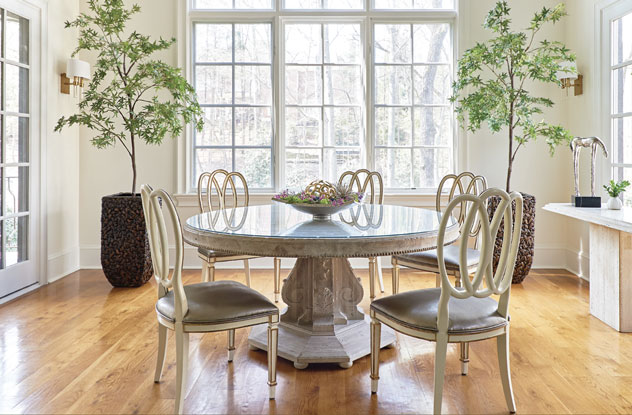
In the dining room above, biophilic elements are abundant sunlight,
fractal patterning of the greenery, natural color tones and wood grain
on the floor.
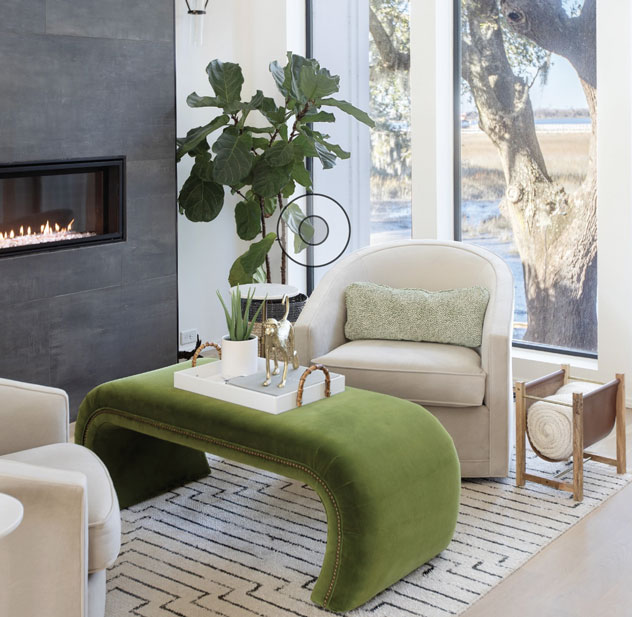
The sitting area has natural sunlight, fire, a fractal pattern in the
carpet, fluid curviness in the chair, greenery and a window view
characteristic of the biophilic property of prospect and refuge.
Movement: Retailers may be tempted to introduce biophilic
design into their showrooms by choosing products and expanding into product
categories such as plants, water features and other items that reflect the
15 principles. Peterson suggested that instead it should start with the
merchandising of the space rather than looking for and placing specific
products. “Retailers can visit Phillips Collection, Currey and Company, and
others, but the starting point to effective neuroaesthetic design has to do
with the movement inside of a space,” he advised.
“Imagine you are walking through the forest, come across and decide to
follow a deer path. That’s the kind of sensory experience retailers might
want to present to their guests. That can’t be accomplished by displaying
products, even those with natural-looking elements in the same old way.”
“Imagine you are walking through the forest and come upon and follow a deer
path. That’s the kind of experiential feeling a retailer might want to
elicit from their guests."
Mystery: Peterson noted that product selection does have an
important place in this discussion “Once a concept for a space is in place,
additional elements can be added. These could include natural products such
as bamboo and raw wood. A winding trail is a biophilic element. It creates a
sense of mystery that encourages shoppers to ask, ‘What’s around the corner?
Where am I going to end up? What’s at the end of the hallway?’ It is a
fundamental biophilic element.”
Organized Complexity: “Organized complexity is another.
Science now knows that our brains are the perfect example of organized
complexity. We take in eleven million bits of information every second.
Humans must organize that information overload to make sense of the world.
We seek it out, that pursuit satisfies us. Examples of organized complexity
are the image of the blue nautilus shown in this article near the top of
page 26, a fern or a variety of patterns that may not be product-based in
nature.
“Our brains seek out details,” Kafka interjected. “A lot of people will
argue they prefer uncluttered modern design. Research demonstrates that
being in that kind of sterile environment can negatively affect mood. That’s
not to say that creating sterile-looking spaces is poor design; they might
not be the best choice for everyone based on the research.”
Awe: “Another biophilic concept to consider is awe. A
sunset is something in nature we often associate with the feeling of awe.
Built environments can evoke a similar feeling. This concept is the 15th
principle of biophilic design.”
Not Only for the High-End
People visit furniture stores for many reasons and with various agendas.
Perhaps their “old green sofa” is past its prime, torn, soiled or
uncomfortable. A shopper’s stated concerns when they first speak to a
salesperson may be that they want their new purchase to fit, be affordable
and delivered within a certain time frame.
Peterson believes, however, that everyone deserves to be offered and should
be offered the benefits of products designed with neuroaesthetic research in
mind, regardless of income.
“Most anyone can access beauty by just stepping outside and running through
the grass in bare feet. That alone can contribute incrementally to improved
health. There’s no reason why retail showrooms and displayed products at any
price point cannot address the principles of neuroaesthetics. The benefit
depends on how that customer’s mind and body react to the green replacement
sofa mentioned earlier in this article. The physical reaction in the brain
that results when someone perceives beauty is what we are talking about.”
The Research
“Over the last 30 years,” Peterson observed, “scientists have introduced a
new word, neuroaesthetics, into our vocabulary. It’s important to note that
the research tends to look at a broad interpretation of aesthetics that
include built environments as well as nature and the arts. Those who study
these relationships are convinced that exposure to beauty of any kind can
improve health. That’s why Science in Design stresses the word beauty as a
way to simplify the messaging. Some research examples are:
-
Susan Magsamen just authored the book, ‘Your Brain on Art.’ She writes
about all elements of beauty, aesthetics and the arts—music, dance,
acoustics, olfactory, tactile—all of them capable of producing pleasure
and having the ability to reduce stress and thereby lower cortisol
levels.
-
Magsamen also wrote a 2019 study published in Frontiers of Psychology
confirming (her words) ‘that spending just 20 minutes in nature...
significantly lowers the levels of the stress hormone cortisol. As
Andrew Huberman, a neuroscientist at Stanford, explains, the act of
looking at a horizon or a broad vista releases a mechanism in the brain
stem that can reduce anxiety and the stress response by changing how you
view and perceive your environment.’
-
A Chiba University study done in the early 1990s, found that 420
patients who spent time in the forest as a way to reduce stress showed
an average decrease in their cortisol levels of 12.4 percent and a
reduction in heart rate by six percent. I think what we are seeing is
the calming influence of nature’s beauty and aesthetics that include:
the fractal beauty of nature, bird sounds, water streams, the view of
the sun filtering through the canopy and the pleasure of the moss
beneath our feet. Forest bathing (Shnrin-yoku) is now a full-fledged
medicine prescribed by Japanese doctors.”
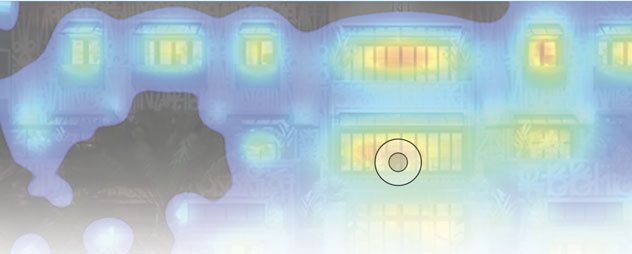
Pictured is a heat map of the front of a furniture store’s exterior.
A Familiar Approach
When asked if Science in Design’s approach to marketing is similar to the
way the ‘science of sleep’ is used to sell bedding, Peterson pointed out
that selling the science of sleep has very little to do with beauty.
However, Kafka did see a parallel. “As human beings, she said, we need
restorative sleep environments that allow us to calm down, fall and stay
asleep. The health benefits have been documented by years of scientific
research in sleep labs. The sleep industry has tapped into this research to
sell more mattresses, but the furnishings industry has not yet embraced
science and the health benefits of neuroaesthetics in a meaningful way.”
IKEA, Etsy, Apple & RH
“IKEA, Etsy, Apple, and other companies in the furniture, cosmetics and food
industry have already tapped into neuroscience as a way to affect the
customer experience of their brands,” Kafka explained.
“Retailer RH has already incorporated these principals into their stores,”
Peterson added. “Restoration Hardware totally gets it. They are 100%
biophilic inside their West Palm Beach store, designed by Hobbs + Black
Architects, and the store’s exterior uses principles of neuroaesthetics.
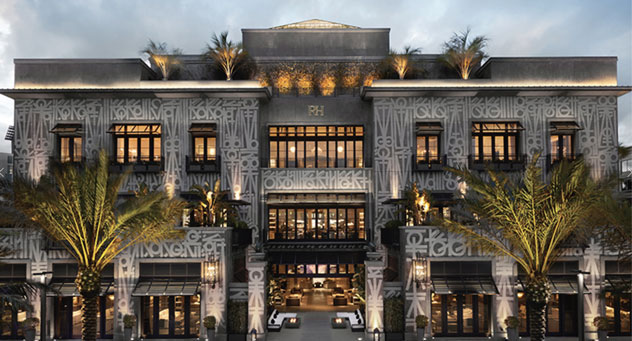
Restoration Hardware understands neuroaesthetics and biophilia. Store
exteriors and interiors are designed and merchandised for the
unconscious mind—the subliminal brain.
“IKEA, Etsy, Apple, and other companies in the furniture, cosmetics and food
industry have already tapped into neuroscience as a way to affect the
consumer’s experience of their brands.”
“The application of neuroaesthetics affects productivity and creativity
within business organizations as well. That’s why Microsoft is now building
conference rooms in treetops. Amazon created The Spheres at its headquarters
in Seattle. Inside, there are 390 different species of plant life. Every
workstation at Apple’s new headquarters has sunlight and greenery. Large
companies have invested to create better work environments. Now it’s up to
the home furnishings industry to provide nurturing home environments for its
customers.”
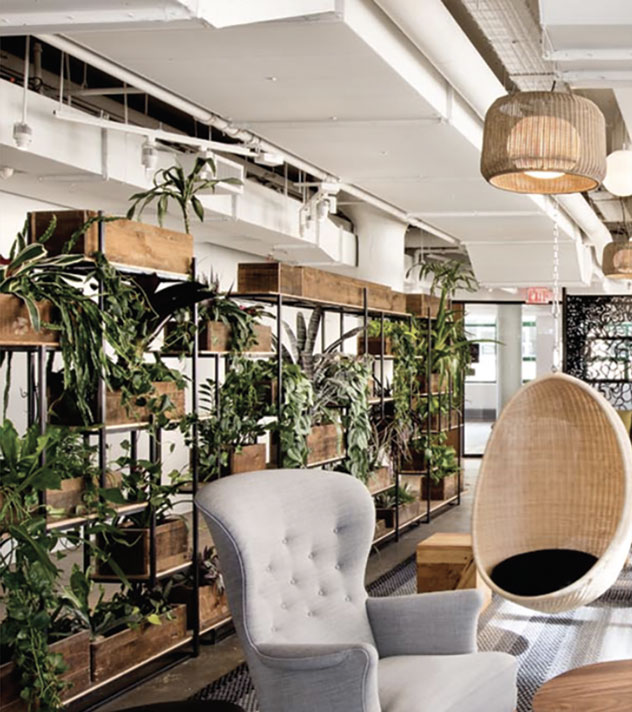
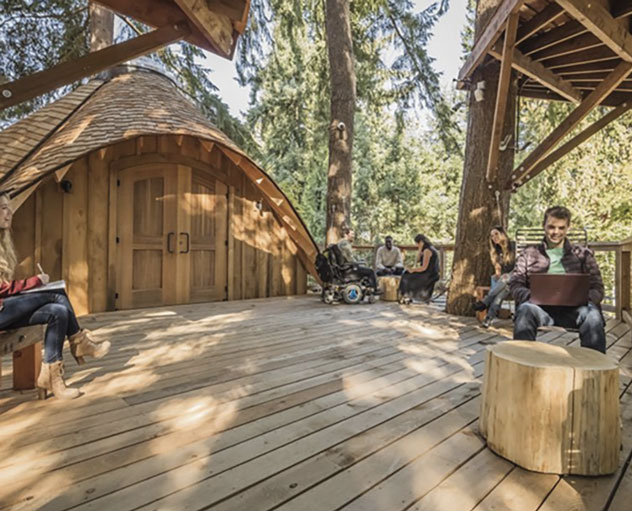
Microsoft building treetop conference rooms and Etsy's 100% biophilic
office spaces in Brooklyn, New York, that feature plants and hanging
cocoon workstations.
Direct & Indirect Effects
Kafka explained that biophilic design elements can either be direct or
indirect. “The direct experience of nature,” she said, “means bringing
natural sunlight, greenery, fire features, running water and other real
natural elements into interior environments. Science shows that indirect
elements—which are representations of nature—are health-producing as well.
Living plants hanging on a wall and fabric or wallpaper representations of
those plants elicit similar biometric responses.”
When asked if decorating with photos of pets or elements that remind people
of social and family connections that have also been shown to have health
benefits could offer similar benefits, Kafka noted, “Humans are attracted to
faces. It’s a behavior that begins at birth and is necessary for survival.
Living with pets and having meaningful social relationships has been shown
to yield health benefits as well.”
Continuing, she explained there are many indirect ways to incorporate
biophilic design elements. “For example, Mohawk Carpets, with the guidance
of Richard Taylor, a faculty member at Science in Design, have created a
carpet that’s scientifically designed to induce a calming effect. We’re
seeing companies, especially in the commercial sector tapping into this, and
it won’t be long before products tested in this way are introduced in the
residential sector.”
What People Want
“Most people don’t even know what the word neuroaesthetic means,” said
Peterson. “Creating that awareness is an educational and a marketing process
that we have to somehow learn, embrace and market as an industry. The idea
of creating a beautiful home isn’t a new idea, but the fact that it’s
actually good for health is.”
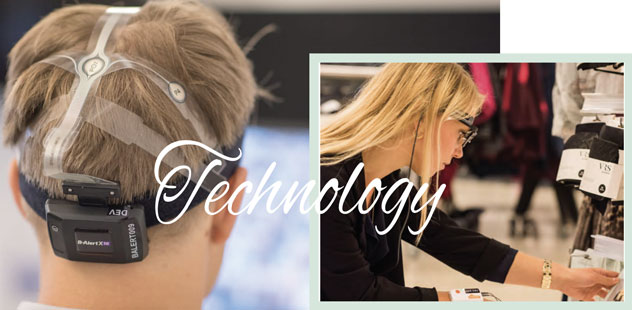
Pictured is a woman participating in an in-store study wearing
portable eye tracking glasses. Also, an EEG headset used in a
neuromarketing study. Photo credit - iMotions.
Amazing Retail Technology
Furniture World asked Kafka and Peterson how manufacturers and retailers
might develop the necessary expertise.
“That’s a really good question,” Peterson replied. “There are many sources
out there that can help. I don’t want to be self-serving, but they can call
Linda or me as a first step. We’re not academics but we can certainly
connect them with people who can help.”
Measuring Response: “Exciting technologies,” he continued, “are available
that can help retailers measure the attractiveness of any space to the
brain’s eye. The science is made possible because the subliminal brain
anticipates by three or four seconds how a shopper will respond when
entering any new environment. Visual Attention Software by 3M (https://vas.3m.com), for example, measures what visitors are likely to see when something new
enters their visual field.” The software allows companies to measure
response and then refine designs until visual goals have been met.
“We are attracted to edges, faces, color contrast and intensity,” Peterson
added. “This attraction is rooted in our ancient brain. Heat mapping and hot
spotting measure how different showroom designs are likely to play out in a
store environment. Measuring is a great place to start and a much better
idea than a strategy of jamming more products into a space. Instead, focus
on hard edges and strong color contrasts, then measure the result with
technology.
“We also use NIX sensors, which capture and identify the color of any
surface. This allows designers to correctly identify colors and match them
to various paint palettes globally. Why is this important? Color is perhaps
one of the hardest aspects of interiors to get right. If done correctly,
color has proven benefits to support health.
“Another software solution Linda and I are investigating is iMotions. The
company says that ‘iMotions combines the full scope of consumer neuroscience
tools in one platform; facial coding, eye tracking, and biometric data like
heart rate, galvanic skin response (GSR), and EEG to measure brain
activity.’ A headset worn by a test subject or shopper can measure the seven
different primary emotions that may be experienced when entering a space.”
These kinds of tools are new to the home furnishings industry, but they’ve
been around for a while. “Companies like Proctor & Gamble have used them to
test and optimize packaging design,” Kafka noted. “Some of the bigger retail
companies also use these tools to measure what positively attracts customer
attention and influences purchase behaviors.”
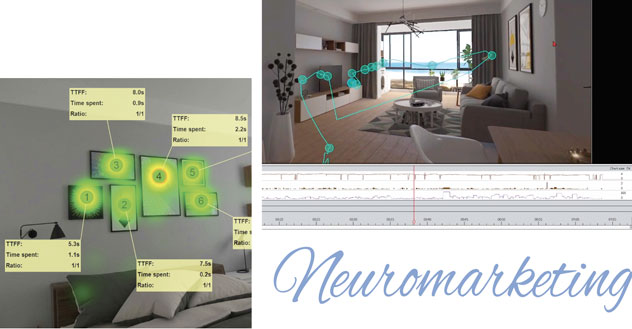
Leading-edge methods assess consumer behavior and emotions in response
to stimuli. This allows companies to make adjustments to improve
showroom displays, packaging and marketing materials. Image credit -
iMotions.
Product Selection
“I want to make it clear,” emphasized Peterson, “that the word ‘trend’ is
not something we allow into our conversation of biophilic design, which is
based on a growing awareness of our evolutionary inheritance. Style and
color trends come and go. Biophilia is a different and fundamental principle
of design. Although biophilia seems like an odd word to some, it simply
means love of nature.
“On the product side, we’re working with manufacturers Furniture World
readers are familiar with, who are developing collections based on science,
neuroaesthetics and biophilia that will make it easier for retailers down
the road to get started.”
The Future of Retail
“What’s really interesting for the future of brick-and-mortar,” Kafka added,
“is that one day shoppers may be able to use wearables while shopping that
measure their physical responses to biophilic design. This has the potential
to take some of the subjectivity and doubt out of home furnishings purchase
decisions.”
“At the 2019 Milan exhibition Linda referenced earlier,” Peterson recalled,
“we walked through three rooms having different visual and experiential
environments wearing wristbands that measured our physical responses. It
turned out that people weren’t always as in touch with their biology as the
wearable technology was.” In other words, their perceptions of how a room
design affected their physical response didn’t always agree with the actual
biometrics.
Certifications
The biophilic duo agreed that there is a potential for companies and
retailers to introduce these concepts in the wrong way, resulting in a kind
of biophilic greenwashing.
“Last year, we held a series of Science in Design summits for interior
designers and architects,” said Peterson. “A major request from attendees
was for Science in Design to create an accredited certification program.
This year, we consulted with our faculty members and universities to create
course material that will have a soft launch in September 2023.
“The self-paced online course will include evidence-based case studies,
contributed by interior designers who incorporate neuroaesthetic principles
in their client work. There will be a biophilic color component and other
modules to round out the program, making it useful to product designers,
home furnishings manufacturers and retail merchandisers who want to be
accredited and certified in the science and design.”
“Hooker Furnishings, Phillips Collection, Benjamin Moore and others have
partnered with us to create the certification program,” added Kafka. And
they are working with us to get the message out. It’s just a matter of time
before retailers see companies making major product introductions. The
pressing question for retailers is whether they will know how to create an
experiential environment for those furniture lines and help customers
understand the benefits.”
Conclusion
“We already mentioned some major brands that employ neuroaesthetics and
biophilia to create healthy environments for their employees,” said
Peterson. “Hospitals all around the world are doing the same. Some examples
are the Khoo Teck Puat Hospital in Singapore and the Maggie’s Centre in
Leeds, United Kingdom. These institutions incorporate multiple patterns,
fluidity, color tones and sunlight in their facilities. Major corporations
and hospitals around the world are using neuroaesthetics and biophilia to
improve the health of their clients and patients. The question is why
wouldn’t our industry use the same principles? We believe that it’s really
important for us to catch up, both for our customers’ sake and our own.”
Editor’s Note:
Science in Design will produce the Science, Art & Design Symposium, a
three-day event experience in High Point, NC, October 12-15, 2023. More
details will be posted to
www.scienceindesign.com
soon.